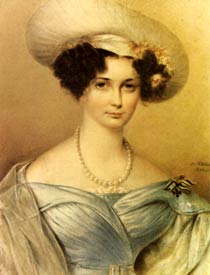Auguste von Harrach
Auguste Countess of Harrach (born August 30, 1800 in Dresden ; † June 5, 1873 in Bad Homburg vor der Höhe ) was the second wife of King Friedrich Wilhelm III as Princess of Liegnitz . of Prussia .
Life

Auguste, who came from the Austrian noble family Harrach , was the daughter of Count Ferdinand Joseph von Harrach zu Rohrau (1763–1841) and Christiane Freiin von Rayski (1767–1830). She met her future husband in Teplitz , Bohemia, in 1822 when he was there for a cure.
King Friedrich Wilhelm III. was married to Luise von Mecklenburg-Strelitz, who was popular in Prussia, since 1793 and was widower since 1810. The connection with Auguste Countess von Harrach was problematic for the 54-year-old king, because the countess did not come from a ruling house, was 30 years younger and, moreover, a Catholic.
The Harrach family had belonged to the imperial count since 1627 , but belonged to the lower nobility. Ferdinand Bonaventura II von Harrach had, however, obtained admission to the Swabian Imperial Counts College for himself and the descendants of his brother Friedrich August in 1752 , namely as a "personalist" (ie without acquiring any territory directly under the Empire ). So that the family had indeed in the ancient kingdom of the empire state stem reached, but lack reign over a territory so to speak, "second class". Auguste belonged to this line as the great-granddaughter of Friedrich August. After the end of the Old Kingdom, this line belonged to the rulers in the German Confederation who were assigned to the high nobility , i.e. to the families who, according to the German Federal Act of June 16, 1815 , retained equality with the houses that continued to rule. However, the individual house law of the Prussian line of the Hohenzollerns made higher demands on the marriages of the members of the royal house, namely the choice of wives from the ruling house . In Austria-Hungary , too , the head of the younger line of the Harrach family was only granted the title of exaltation by a decree of the Imperial and Royal Court Chancellery in 1841 due to his former “personalist” status . In any case, the Hohenzollerns considered the marriage to be a morganatic marriage .
The marriage on November 9, 1824 was therefore initially kept secret. The wedding took place in the Charlottenburg Palace Chapel, and Auguste received the titles of Princess of Liegnitz and Countess of Hohenzollern. The king is quoted as saying: “It must not be a queen; I won't get a Luise back. ”The couple initially lived in a hotel on Unter den Linden , and Karl August Varnhagen von Ense reports:“ Our king married the day before yesterday. The news hit the people like a clap of thunder, and most of them refused to believe. "
Auguste was initially an outsider at the Berlin court and, because of the morganatic marriage, ranked behind the youngest princes and princesses of the house in the court protocol. Not until May 25, 1826 did she convert to the Protestant faith. The Princess of Liegnitz lived in Berlin in the Prinzessinnenpalais , partly in Schönhausen Palace and in Charlottenburg Palace in the New Wing. The new pavilion designed by Schinkel for the couple in the local palace park was not shared.
Auguste did not appear politically, and the marriage remained childless. Although she was able to ensure the respect of the family in the last few months when she was nursing the sick king, she was not allowed to attend the funeral service for her husband in the Berlin Cathedral because of the low ranking in the court protocol .
Since 1840, the Princess Liegnitz continued to live in the Prinzessinnenpalais in Berlin as a widow with sufficient allowance . At the entrance to the Sanssouci Park in Potsdam, she had Albert Dietrich Schadow convert the Villa Liegnitz for her, and she lived in Villa Auguste in La Tour-de-Peilz on Lake Geneva . The area was later used as a hotel. Today it is called Rive-Reine and belongs to the Nestlé group.
On many trips Auguste made, she visited Switzerland, Florence, Rome and England. She died in 1873 during a spa stay in Bad Homburg. She is buried in the crypt of the mausoleum in the Charlottenburg Palace Park near her husband, but there is no grave or memorial plaque there.
She was a godmother of her nephew, the painter Ferdinand von Harrach (1832-1915), a son of her brother Carl Phillip.
literature
- Constantin von Wurzbach : Harrach, Auguste Countess von . In: Biographisches Lexikon des Kaiserthums Oesterreich . 7th part. Imperial-Royal Court and State Printing Office, Vienna 1861, p. 372 ( digitized version ).
- Wichard Graf Harrach: Auguste Princess of Liegnitz. Your years at d. Page of King Friedrich Wilhelm III. von Prussen (1824-1840). Stapp, Berlin 1987, ISBN 3-87776-190-9 .
- Gisela and Paul Habermann: Princess of Liegnitz. A life in the shadow of Queen Luise. Nicolai, Berlin 1988, ISBN 3-87584-229-4 .
Web links
- Literature by and about Auguste von Harrach in the catalog of the German National Library
- Biography at the Prussian Palaces and Gardens Foundation
- Biography on the Hohenzollern homepage
- Biography, literature & sources on Auguste von Harrach FemBio of the Institute for Women's Biography Research
- Harrach, Auguste Countess in Constant von Wurzbach : Biographical Lexicon of the Empire of Austria . 7th volume, Vienna 1861.
| personal data | |
|---|---|
| SURNAME | Harrach, Auguste von |
| ALTERNATIVE NAMES | Liegnitz, Auguste Princess of |
| BRIEF DESCRIPTION | Wife of King Friedrich Wilhelm III. of Prussia |
| DATE OF BIRTH | August 30, 1800 |
| PLACE OF BIRTH | Dresden |
| DATE OF DEATH | June 5, 1873 |
| Place of death | Bad Homburg vor der Höhe |



